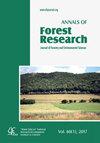银杉(Abies alba Mill.)分布范围东南边界的遗传多样性和结构
IF 2.9
3区 农林科学
Q2 FORESTRY
引用次数: 10
摘要
在罗马尼亚喀尔巴阡山脉,银杉覆盖了约5%的森林面积,是第二重要的针叶树物种。尽管对欧洲冷杉遗传多样性的分布进行了大量的遗传研究,但对其分布范围东南边界的种群研究较少。本研究利用7个微卫星位点,对罗马尼亚喀尔巴阡山脉36个银杉种群的遗传多样性和分化进行了评价。所有群体的遗传多样性均较高(He = 0.779 ~ 0.834, AR = 11.61 ~ 14.93)。与南部种群相比,东部喀尔巴阡山脉种群在等位基因丰富度和预期杂合度方面表现出更高的多样性水平,遗传分化程度也更高。贝叶斯聚类分析表明,银杉种群存在两个遗传上明显不同的类群,一个较大的类群包括内喀尔巴阡山脉、曲喀尔巴阡山脉、南喀尔巴阡山脉和巴纳特山脉,第二个类群包含大部分北喀尔巴阡山脉和外喀尔巴阡山脉种群。AMOVA和Barrier分析均支持种源区域间的遗传分化。东缘银杉种群遗传多样性高,为缓解气候变暖带来的不利影响提供了巨大潜力,是全球变化背景下宝贵的遗传资源。森林遗传资源在地方、区域和国家尺度上的遗传变异分布格局可以而且应该作为森林遗传资源保护的考虑因素。本文章由计算机程序翻译,如有差异,请以英文原文为准。
Genetic diversity and structure of Silver fir (Abies alba Mill.) at the south-eastern limit of its distribution range
In the Romanian Carpathians, Silver fir covers about 5% of the forest area and is the second most important conifer species. Although there are a number of genetic studies concerning the distribution of genetic diversity of Abies alba in Europe, populations from the south-eastern limit of the distribution range have been studied less. The aim of the present study was to assess the genetic diversity and differentiation in 36 silver fir populations along the Carpathian Mountains in Romania, using seven microsatellites loci. High levels of genetic diversity (He = 0.779 to 0.834 and AR = 11.61 to 14.93) were found in all populations. Eastern Carpathians populations show higher levels of diversity, both in allelic richness and expected heterozygosity and higher degrees of genetic differentiation compared to southern populations. Bayesian clustering analysis revealed the existence of two genetically distinct groups for silver fir populations, one larger cluster which comprises the Inner Eastern Carpathians, Curvature Carpathians, South Carpathians and the Banat Mountains and the second cluster contained most of the North and Outer Eastern Carpathians population. Both AMOVA and Barrier analysis supported genetic differentiation among geographical provenance regions. The high genetic diversity of silver fir populations from the eastern limit of its distribution provide high potential to mitigate the negative effects of climate warming being valuable genetic resources in the context of global change. The distribution pattern of genetic variation at local, regional and country scale could and should be considered for the preservation of the forest genetic resources.
求助全文
通过发布文献求助,成功后即可免费获取论文全文。
去求助
来源期刊

Annals of Forest Research
FORESTRY-
CiteScore
2.20
自引率
11.10%
发文量
11
审稿时长
12 weeks
期刊介绍:
Annals of Forest Research is a semestrial open access journal, which publishes research articles, research notes and critical review papers, exclusively in English, on topics dealing with forestry and environmental sciences. The journal promotes high scientific level articles, by following international editorial conventions and by applying a peer-review selection process.
 求助内容:
求助内容: 应助结果提醒方式:
应助结果提醒方式:


